And so our summer comes to an end. These last few weeks have been a very Scottish mixture of wonderful scenery, isolated communities, sunshine and showers with light, occasionally blustery winds.
 We have enjoyed some beautiful weather during much of
Having arrived in Loch Torridon in miserable weather conditions it was wonderful to wake the next morning to a dry few days becoming ever sunnier – allowing splendid views of the majestic mountains, including several Munros, all around this magnificent loch. We enjoyed some excellent walks, and took the boat right to the far end of the loch where we anchored for a couple of nights – in worryingly shallow and rocky locations not typically frequented by yachts. We made a dinner booking at the extremely swanky ‘The Torridon’ – a typical Victorian Scottish Baronial style ‘castle’- who told us they had only ever had one visitor from a yacht! Perhaps not surprising given the difficulty of getting ashore across a large expanse of seaweed covered rocks.
We have enjoyed some beautiful weather during much of
Having arrived in Loch Torridon in miserable weather conditions it was wonderful to wake the next morning to a dry few days becoming ever sunnier – allowing splendid views of the majestic mountains, including several Munros, all around this magnificent loch. We enjoyed some excellent walks, and took the boat right to the far end of the loch where we anchored for a couple of nights – in worryingly shallow and rocky locations not typically frequented by yachts. We made a dinner booking at the extremely swanky ‘The Torridon’ – a typical Victorian Scottish Baronial style ‘castle’- who told us they had only ever had one visitor from a yacht! Perhaps not surprising given the difficulty of getting ashore across a large expanse of seaweed covered rocks.
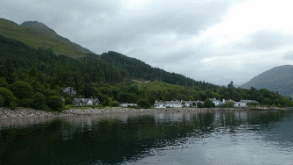 The highlight of this time was our visit to the village of Torridon at the head of the loch.
On landing at a stone jetty off the village we immediately picked up a warm and friendly feel to the place – pretty little cottages, a good shop and café - a welcoming community ambience. We were there on a mission - to investigate the life of a very long-ago work colleague. This turned out to be a wonderfully heart-warming and poignant experience as we discovered what a very positive contribution she and her artist husband had made to the community and how fondly they were remembered.
The highlight of this time was our visit to the village of Torridon at the head of the loch.
On landing at a stone jetty off the village we immediately picked up a warm and friendly feel to the place – pretty little cottages, a good shop and café - a welcoming community ambience. We were there on a mission - to investigate the life of a very long-ago work colleague. This turned out to be a wonderfully heart-warming and poignant experience as we discovered what a very positive contribution she and her artist husband had made to the community and how fondly they were remembered.
Still heading north, we headed for Gairloch, the next mainland loch. This was an idyllic passage with stunningly beautiful views around us – the magnificent mainland peaks to the east, the northern tip of Skye – so familiar from last year – to the west and out northwest to the Shiants against the background of the Outer Hebrides.
Badachro is a pretty and sheltered bay, where we picked up a visitors’ buoy.
As luck would have it there was a barbecue and live music at the pub on our arrival, and we enjoyed a very lively evening there - heaving with a mix of locals and a few visitors - despite the pouring rain! The live music was a guitar player/singer with a particularly melodious voice accompanied by a cajon (a box shaped percussion instrument) player. It transpired that the latter is based in Bristol and the singer, now based in Cheltenham, spent several years managing the Llandoger Trow in Bristol!
Disaster then struck! We had left the dinghy on a rough stone jetty swarming with midges and covered in slimy seaweed. Julia stepped into the dinghy but then somehow fell back as it bounced off, getting soaked before Chris hauled her back in. That was just the start, as back on board Aremiti, while Julia was stripping off wet clothing, Chris had a significant dizzy turn – worryingly reminiscent of what happened earlier this year. However he quickly improved and, in the absence of any other symptoms and after a good night’s sleep, it seemed prudent to make this our furthest point north - which we had more or less decided anyway – and head back to ‘civilisation’. A phone consultation with the GP was reassuring. We enjoyed a day taking it easy in warm sunshine, planning our route south to visit locations we had missed on our way north.
 As we left Gairloch the survey vessel Sir David Attenborough came in to anchor – which turned out to be the highlight of a slow and tedious passage in drizzle and low visibility back down to the Kyle of Lochalsh – what passes for ‘civilisation’ in these parts with the sizeable population of 590!
As we left Gairloch the survey vessel Sir David Attenborough came in to anchor – which turned out to be the highlight of a slow and tedious passage in drizzle and low visibility back down to the Kyle of Lochalsh – what passes for ‘civilisation’ in these parts with the sizeable population of 590!
Here we moored to a rickety pontoon which leapt around wildly in the wash from passing ships, but meant, for the first time in 13 days, we could simply walk ashore. It was all a bit anti-climactic – Kyle of Lochalsh was underwhelming to put it kindly, though much redeemed by the magnificent view of the Skye Bridge and the mountains and islands beyond. It served its purpose as a pit-stop - getting laundry and boat cleaning done, picking up fuel for the generator and reprovisioning from the best supermarket we’d seen for quite some time – particularly in the fresh fruit and veg. department.
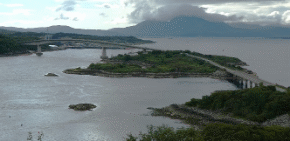 While there we had an interesting and delightful walk to Eilean Ban, the island once owned by Gavin Maxwell and now site of a couple of the Skye Bridge piers. After viewing the fascinating Maxwell memorabilia, we walked out to and up the lighthouse and then into An Plock – a promontory owned by the Kyle and Lochalsh Community Trust who have developed access to this beautiful area of wild flower meadows, native woodland, a series of hidden rocky coves and a great viewpoint.
While there we had an interesting and delightful walk to Eilean Ban, the island once owned by Gavin Maxwell and now site of a couple of the Skye Bridge piers. After viewing the fascinating Maxwell memorabilia, we walked out to and up the lighthouse and then into An Plock – a promontory owned by the Kyle and Lochalsh Community Trust who have developed access to this beautiful area of wild flower meadows, native woodland, a series of hidden rocky coves and a great viewpoint.
 Moving on, we went back down Kyle Rhea on a dreich day – a flukey sailing wind shooting between nothing and 20 knots – joyfully accompanied by three splendid gaff riggers.
We experienced 30 knot gusts in the slightly tricky entrance into Loch Nevis before picking up a buoy in relative calm off the village of Inverie.
Moving on, we went back down Kyle Rhea on a dreich day – a flukey sailing wind shooting between nothing and 20 knots – joyfully accompanied by three splendid gaff riggers.
We experienced 30 knot gusts in the slightly tricky entrance into Loch Nevis before picking up a buoy in relative calm off the village of Inverie.
We’ve visited a number of these sea lochs – discovering just how remote the peninsulas between them are. Their settlements are tiny and very remote - not unlike islands.
Inverie is the main settlement on the Knoydart Peninsula, and is especially like an island - sandwiched between Lochs Nevis and Hourn - "Loch Heaven" - Gaelic Loch Neimh and "Loch Hell" Gaelic: Loch Lutham respectively. Its 8 miles of tarred road in the south west of the peninsula are not connected to the UK road system and Inverie is only accessible by boat, or by a 15 mile trek from the nearest road, through very harsh terrain including 4 Munroes.
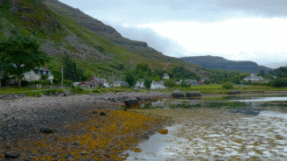 Knoydart suffered from the infamous Highland Clearances and economic emigration during the mid 19th century. However the few remaining inhabitants continued to fight for their freedom. In 1948 the ‘Seven Men of Knoydart’ staked a parcel of land to settle on. Although the landowner obtained a court order for their removal, this defiance became the inspiration for a community buyout of 17,200 acres in 1999. Inverie has subsequently flourished under the stewardship of those who live and work there. With a population of around 120 full time residents the village provides basic amenities including a Post Office and Primary School, along with a community shop. The Old Forge - the remotest pub in mainland Britain - came under community ownership in 2022.
Knoydart, not connected to the National Grid, gets its electricity from a hydroelectric scheme run by a community trust. The ferry delivers orders from Mallaig's Co-op , and Amazon deliveries, are carried out by local postal workers!
The day following our arrival in Inverie was a significant and exciting one for the locals.
Knoydart suffered from the infamous Highland Clearances and economic emigration during the mid 19th century. However the few remaining inhabitants continued to fight for their freedom. In 1948 the ‘Seven Men of Knoydart’ staked a parcel of land to settle on. Although the landowner obtained a court order for their removal, this defiance became the inspiration for a community buyout of 17,200 acres in 1999. Inverie has subsequently flourished under the stewardship of those who live and work there. With a population of around 120 full time residents the village provides basic amenities including a Post Office and Primary School, along with a community shop. The Old Forge - the remotest pub in mainland Britain - came under community ownership in 2022.
Knoydart, not connected to the National Grid, gets its electricity from a hydroelectric scheme run by a community trust. The ferry delivers orders from Mallaig's Co-op , and Amazon deliveries, are carried out by local postal workers!
The day following our arrival in Inverie was a significant and exciting one for the locals.
 After many months of planning struggles and physical refurbishment, the Old Forge re-opened, to the skirl of bagpipes. We spent a fascinating evening chatting with locals in a very heady atmosphere. The couple we spoke with described life in Knoydart, now thriving under the buy-out. She works for the Knoydart Forest Trust and their two daughters have remained in Knoydart, one working as the nursery school teacher and the other crofting. We were told how the previous Belgian owner of the pub, who had fancied himself as providing a fine dining establishment, had effectively driven away the locals. The community buy-out aims to re-instate a local pub type atmosphere, with a more realistic and less aspirational/expensive eating venue.
We also enjoyed a delightfully pretty woodland walk with many varieties of deciduous trees in addition to the ubiquitous conifers, and notable for a lavish abundance of moss and fungi.
After many months of planning struggles and physical refurbishment, the Old Forge re-opened, to the skirl of bagpipes. We spent a fascinating evening chatting with locals in a very heady atmosphere. The couple we spoke with described life in Knoydart, now thriving under the buy-out. She works for the Knoydart Forest Trust and their two daughters have remained in Knoydart, one working as the nursery school teacher and the other crofting. We were told how the previous Belgian owner of the pub, who had fancied himself as providing a fine dining establishment, had effectively driven away the locals. The community buy-out aims to re-instate a local pub type atmosphere, with a more realistic and less aspirational/expensive eating venue.
We also enjoyed a delightfully pretty woodland walk with many varieties of deciduous trees in addition to the ubiquitous conifers, and notable for a lavish abundance of moss and fungi.
Next stop was a brief return visit to the island of Eigg – having discovered that Bristol friends Claire and Laurence were currently there on holiday. We enjoyed a delightful afternoon stroll with them along the southern shoreline and past an ancient church and graveyard, followed by a meal in the café - not too put out by the fact that this weekend the island was overwhelmed with visitors to the ‘Howlin’ Fling Festival.
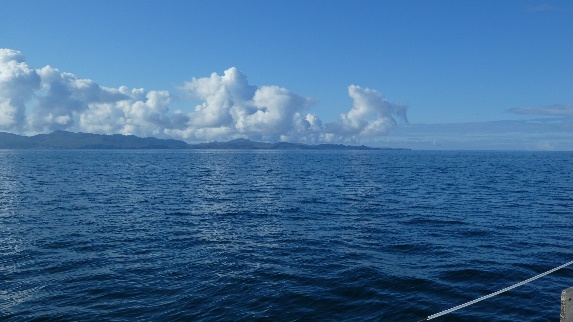 Onwards to the island of Coll in a glassy sea - noting a very slight and benign swell, emanating, we assumed, from Storm Antoni which had been battering the southern UK, while ignoring us. This was another passage for relishing and soaking in the heart-aching beauty of the highlands and islands.
Onwards to the island of Coll in a glassy sea - noting a very slight and benign swell, emanating, we assumed, from Storm Antoni which had been battering the southern UK, while ignoring us. This was another passage for relishing and soaking in the heart-aching beauty of the highlands and islands.
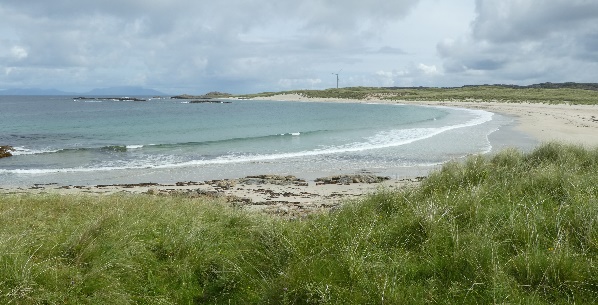 There is something compelling about hard to reach islands, and Coll, with little shelter from the Atlantic and only rather precarious anchorages, had been a long held objective. We were thrilled that conditions had come right at such a convenient time for us.
There is something compelling about hard to reach islands, and Coll, with little shelter from the Atlantic and only rather precarious anchorages, had been a long held objective. We were thrilled that conditions had come right at such a convenient time for us.
We picked up a buoy off Arinagour - the island’s main settlement and ‘harbour’ – more an inlet scattered with rocks and islets, drying at the head, several visitors moorings, a stone jetty and a large ferry pier out at its entrance.
We checked out the island (3 by 13 miles) by walking across to the opposite coast.
 Reminiscent of the Outer Hebridean islands, the east side is boggy, rocky and rugged – not much livestock, plenty of heather. On the west side the terrain is softer - gently undulating machair with more livestock. Very few trees anywhere. We were passed by a surprising number of vehicles – indication of busy, thriving place. We took a break at Cliad Bay, one of many west coast beaches – pale sand backed by clumps of maram grass in low dunes, seaweed and islands off the shore covered in gulls with Barra and South Uist faintly visible on the horizon. Beautiful.
Lunch in the island café was without drinks - supply was critically low until the next ferry - due to arrive the following evening. In the meantime they’d have to close the next day.
Reminiscent of the Outer Hebridean islands, the east side is boggy, rocky and rugged – not much livestock, plenty of heather. On the west side the terrain is softer - gently undulating machair with more livestock. Very few trees anywhere. We were passed by a surprising number of vehicles – indication of busy, thriving place. We took a break at Cliad Bay, one of many west coast beaches – pale sand backed by clumps of maram grass in low dunes, seaweed and islands off the shore covered in gulls with Barra and South Uist faintly visible on the horizon. Beautiful.
Lunch in the island café was without drinks - supply was critically low until the next ferry - due to arrive the following evening. In the meantime they’d have to close the next day.
The history of the island is all too familiar. By the late 18th century the population was about 1,000 people supported by agriculture and fishing. However, the collapse in the kelp market after the end of the Napoleonic Wars followed by the Highland Potato Famine caused great hardship and by the mid 19th century, half the population had emigrated, many to Australia, Canada, or South Africa. In 1848, the heir of the Macleans of Coll himself emigrated to South Africa. The Coll lands are now owned by a Trust, the RSPB, and individual farmers and crofters.
Today the population, currently 220, is growing again – faster than on many other islands. One couple, whose four children have all moved back to Coll to raise their own sons and daughters, have received the community’s “Oscar” for best breeder, as their family of 21 now make up 10% cent of the island’s population!
Employment ranges from tourism to fishing and farming. The largest employer is Project Trust – an organisation providing ethical international volunteering opportunities for young people.
The island has a shop, cafe, hotel and pub, doctor, and post office – all in private hands.
Development Coll was formed in 2006, to tackle local issues and help build a vibrant and sustainable community, and owns the Community centre, and a hostel.
In December 2013 Col, with no street lights, secured ‘Dark Skies’' status.
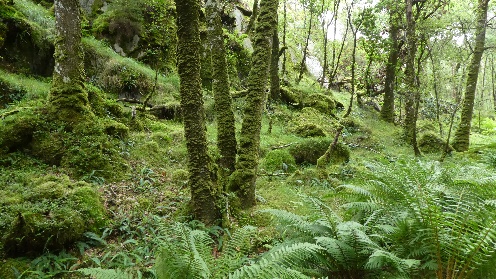 With a forecast of strong easterlies – not good for a stay on Coll – we beat a retreat, heading for Loch Sunart at the north east of the Sound of Mull. A comfortable if slow sail across to the mainland gave us a lingering vista of the Small Isles behind Ardnamurchan Point – perhaps our favourite view? The wind dropped for the ‘inland’ part of the passage – into the Sound of Mull and into Loch Sunart, involving some intricate navigation.
Sunart – at 19 miles the longest sea loch - is gentle and pretty, mountains not too daunting behind the foreground of woods and little settlements on the coast. Halfway into the loch we arrived at Salen, to berth on a pontoon run by an entrepreneurial and hardworking couple from Huddersfield.
Our walk here was through woods, like those around Inverie, typical of the Atlantic Temperate Rainforest which once fringed the coasts of north west Europe. Not spectacular, but full of interest – a good variety of tree species, thick moss and abundant fungi.
We motored, via a set of narrows, right to the head of the loch at Strontian – now a small settlement, but in the 18th century buzzing, with lead mines employing over 500 workers. Its greatest claim to fame is that the element Strontium was discovered here in 1790 and named after the village.
With a forecast of strong easterlies – not good for a stay on Coll – we beat a retreat, heading for Loch Sunart at the north east of the Sound of Mull. A comfortable if slow sail across to the mainland gave us a lingering vista of the Small Isles behind Ardnamurchan Point – perhaps our favourite view? The wind dropped for the ‘inland’ part of the passage – into the Sound of Mull and into Loch Sunart, involving some intricate navigation.
Sunart – at 19 miles the longest sea loch - is gentle and pretty, mountains not too daunting behind the foreground of woods and little settlements on the coast. Halfway into the loch we arrived at Salen, to berth on a pontoon run by an entrepreneurial and hardworking couple from Huddersfield.
Our walk here was through woods, like those around Inverie, typical of the Atlantic Temperate Rainforest which once fringed the coasts of north west Europe. Not spectacular, but full of interest – a good variety of tree species, thick moss and abundant fungi.
We motored, via a set of narrows, right to the head of the loch at Strontian – now a small settlement, but in the 18th century buzzing, with lead mines employing over 500 workers. Its greatest claim to fame is that the element Strontium was discovered here in 1790 and named after the village.
 Our final couple of nights in Loch Sunart were at anchor in Loch Drambuie. With all round shelter, this little loch is famous for the ‘sunflower’ circle of 183 yachts celebrating the centenary of the Clyde Cruising Club in 2010.
Our final couple of nights in Loch Sunart were at anchor in Loch Drambuie. With all round shelter, this little loch is famous for the ‘sunflower’ circle of 183 yachts celebrating the centenary of the Clyde Cruising Club in 2010.
We motored the 5 miles across to Tobermory in very dreich conditions.
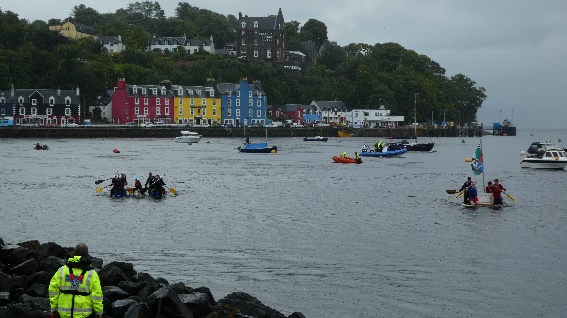 Here we had a date with the cousin of a Bristol friend. Olive, a lovely lady, ran Brown’s Stores (of which we wrote in our first newsletter this year) for many years. Now retired with daughter and son-in-law running the shop, she remains very much engaged in various community activities. Our visit coincided with ‘Tobermory Lifeboat day’ the highlight of which was the raft race across the harbour - in pouring rain, with half the entries disintegrating en route, their crews valiantly swimming their ‘vessels’ in to the finish.
Here we had a date with the cousin of a Bristol friend. Olive, a lovely lady, ran Brown’s Stores (of which we wrote in our first newsletter this year) for many years. Now retired with daughter and son-in-law running the shop, she remains very much engaged in various community activities. Our visit coincided with ‘Tobermory Lifeboat day’ the highlight of which was the raft race across the harbour - in pouring rain, with half the entries disintegrating en route, their crews valiantly swimming their ‘vessels’ in to the finish.
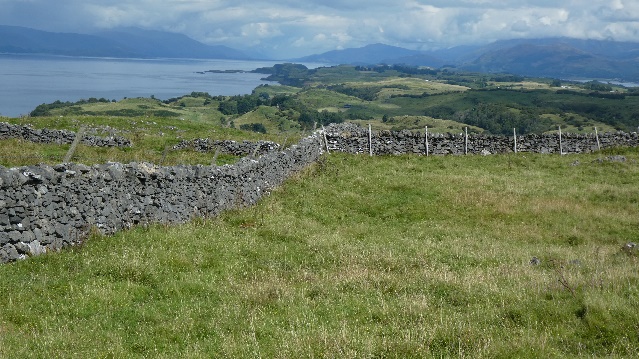 Getting closer to ‘home’ waters we anchored off Lismore Island for a walk promising stupendous views from its strategic location, and from the highest point were well rewarded with views down to Jura, though sadly, Ben Nevis was cloud covered. A major feature of the walk were the numerous very substantial and high dry-stone walls criss-crossing the ridge – built probably by those who cleared the land to contain sheep.
Getting closer to ‘home’ waters we anchored off Lismore Island for a walk promising stupendous views from its strategic location, and from the highest point were well rewarded with views down to Jura, though sadly, Ben Nevis was cloud covered. A major feature of the walk were the numerous very substantial and high dry-stone walls criss-crossing the ridge – built probably by those who cleared the land to contain sheep.
Next a brief couple of nights in Oban with the primary objective of catching up on the latest must-see, and utterly contrasting films – Barbie one night and Oppenheimer the next !

 Puilladobhrain is the beautiful and protected anchorage where it has become traditional for us to stop for a couple of relaxing nights each, en route out and back from our cruising. With our thoughts focussed on our imminent return to ‘base’ and the jobs to be done there, we took our eyes off the ball weatherwise. Storm Betty, nothing like as cosy as her name suggests, came as a sting in the tail at the very end of the summer’s cruise. Heralded by a very dramatic sky and equally dramatic plummet in barometric pressure, we can now personally vouch for the good holding and protection of this anchorage, as we were battered for a rather stressful 24 hours.
Puilladobhrain is the beautiful and protected anchorage where it has become traditional for us to stop for a couple of relaxing nights each, en route out and back from our cruising. With our thoughts focussed on our imminent return to ‘base’ and the jobs to be done there, we took our eyes off the ball weatherwise. Storm Betty, nothing like as cosy as her name suggests, came as a sting in the tail at the very end of the summer’s cruise. Heralded by a very dramatic sky and equally dramatic plummet in barometric pressure, we can now personally vouch for the good holding and protection of this anchorage, as we were battered for a rather stressful 24 hours.
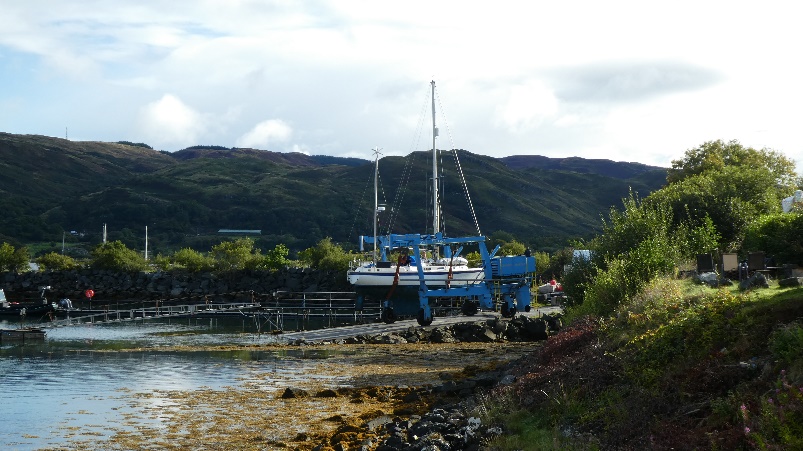 Finally back to where we started in Craobh Haven. The weather finally broke down with strong winds and persistent rain. While glad not to be sailing, making our preparations for winterising the boat and having her hauled out more difficult. Hard to take off sails in winds gusting to 25!
Finally back to where we started in Craobh Haven. The weather finally broke down with strong winds and persistent rain. While glad not to be sailing, making our preparations for winterising the boat and having her hauled out more difficult. Hard to take off sails in winds gusting to 25!
We left Aremiti tucked up ashore for the winter with no firm plans for next year's cruising. We head south with mixed feelings, as usual. A warm house and flushing loo beckon but we leave behind the big skies, fresh air and the challenges of an outdoor life. Next year? Who knows!
Looking forward to seeing you,
Julia and Chris

 We have enjoyed some beautiful weather during much of
Having arrived in Loch Torridon in miserable weather conditions it was wonderful to wake the next morning to a dry few days becoming ever sunnier – allowing splendid views of the majestic mountains, including several Munros, all around this magnificent loch. We enjoyed some excellent walks, and took the boat right to the far end of the loch where we anchored for a couple of nights – in worryingly shallow and rocky locations not typically frequented by yachts. We made a dinner booking at the extremely swanky ‘The Torridon’ – a typical Victorian Scottish Baronial style ‘castle’- who told us they had only ever had one visitor from a yacht! Perhaps not surprising given the difficulty of getting ashore across a large expanse of seaweed covered rocks.
We have enjoyed some beautiful weather during much of
Having arrived in Loch Torridon in miserable weather conditions it was wonderful to wake the next morning to a dry few days becoming ever sunnier – allowing splendid views of the majestic mountains, including several Munros, all around this magnificent loch. We enjoyed some excellent walks, and took the boat right to the far end of the loch where we anchored for a couple of nights – in worryingly shallow and rocky locations not typically frequented by yachts. We made a dinner booking at the extremely swanky ‘The Torridon’ – a typical Victorian Scottish Baronial style ‘castle’- who told us they had only ever had one visitor from a yacht! Perhaps not surprising given the difficulty of getting ashore across a large expanse of seaweed covered rocks.
 The highlight of this time was our visit to the village of Torridon at the head of the loch.
On landing at a stone jetty off the village we immediately picked up a warm and friendly feel to the place – pretty little cottages, a good shop and café - a welcoming community ambience. We were there on a mission - to investigate the life of a very long-ago work colleague. This turned out to be a wonderfully heart-warming and poignant experience as we discovered what a very positive contribution she and her artist husband had made to the community and how fondly they were remembered.
The highlight of this time was our visit to the village of Torridon at the head of the loch.
On landing at a stone jetty off the village we immediately picked up a warm and friendly feel to the place – pretty little cottages, a good shop and café - a welcoming community ambience. We were there on a mission - to investigate the life of a very long-ago work colleague. This turned out to be a wonderfully heart-warming and poignant experience as we discovered what a very positive contribution she and her artist husband had made to the community and how fondly they were remembered.
 As we left Gairloch the survey vessel Sir David Attenborough came in to anchor – which turned out to be the highlight of a slow and tedious passage in drizzle and low visibility back down to the Kyle of Lochalsh – what passes for ‘civilisation’ in these parts with the sizeable population of 590!
As we left Gairloch the survey vessel Sir David Attenborough came in to anchor – which turned out to be the highlight of a slow and tedious passage in drizzle and low visibility back down to the Kyle of Lochalsh – what passes for ‘civilisation’ in these parts with the sizeable population of 590!
 While there we had an interesting and delightful walk to Eilean Ban, the island once owned by Gavin Maxwell and now site of a couple of the Skye Bridge piers. After viewing the fascinating Maxwell memorabilia, we walked out to and up the lighthouse and then into An Plock – a promontory owned by the Kyle and Lochalsh Community Trust who have developed access to this beautiful area of wild flower meadows, native woodland, a series of hidden rocky coves and a great viewpoint.
While there we had an interesting and delightful walk to Eilean Ban, the island once owned by Gavin Maxwell and now site of a couple of the Skye Bridge piers. After viewing the fascinating Maxwell memorabilia, we walked out to and up the lighthouse and then into An Plock – a promontory owned by the Kyle and Lochalsh Community Trust who have developed access to this beautiful area of wild flower meadows, native woodland, a series of hidden rocky coves and a great viewpoint.
 Moving on, we went back down Kyle Rhea on a dreich day – a flukey sailing wind shooting between nothing and 20 knots – joyfully accompanied by three splendid gaff riggers.
We experienced 30 knot gusts in the slightly tricky entrance into Loch Nevis before picking up a buoy in relative calm off the village of Inverie.
Moving on, we went back down Kyle Rhea on a dreich day – a flukey sailing wind shooting between nothing and 20 knots – joyfully accompanied by three splendid gaff riggers.
We experienced 30 knot gusts in the slightly tricky entrance into Loch Nevis before picking up a buoy in relative calm off the village of Inverie.
 Knoydart suffered from the infamous Highland Clearances and economic emigration during the mid 19th century. However the few remaining inhabitants continued to fight for their freedom. In 1948 the ‘Seven Men of Knoydart’ staked a parcel of land to settle on. Although the landowner obtained a court order for their removal, this defiance became the inspiration for a community buyout of 17,200 acres in 1999. Inverie has subsequently flourished under the stewardship of those who live and work there. With a population of around 120 full time residents the village provides basic amenities including a Post Office and Primary School, along with a community shop. The Old Forge - the remotest pub in mainland Britain - came under community ownership in 2022.
Knoydart, not connected to the National Grid, gets its electricity from a hydroelectric scheme run by a community trust. The ferry delivers orders from Mallaig's Co-op , and Amazon deliveries, are carried out by local postal workers!
The day following our arrival in Inverie was a significant and exciting one for the locals.
Knoydart suffered from the infamous Highland Clearances and economic emigration during the mid 19th century. However the few remaining inhabitants continued to fight for their freedom. In 1948 the ‘Seven Men of Knoydart’ staked a parcel of land to settle on. Although the landowner obtained a court order for their removal, this defiance became the inspiration for a community buyout of 17,200 acres in 1999. Inverie has subsequently flourished under the stewardship of those who live and work there. With a population of around 120 full time residents the village provides basic amenities including a Post Office and Primary School, along with a community shop. The Old Forge - the remotest pub in mainland Britain - came under community ownership in 2022.
Knoydart, not connected to the National Grid, gets its electricity from a hydroelectric scheme run by a community trust. The ferry delivers orders from Mallaig's Co-op , and Amazon deliveries, are carried out by local postal workers!
The day following our arrival in Inverie was a significant and exciting one for the locals.
 After many months of planning struggles and physical refurbishment, the Old Forge re-opened, to the skirl of bagpipes. We spent a fascinating evening chatting with locals in a very heady atmosphere. The couple we spoke with described life in Knoydart, now thriving under the buy-out. She works for the Knoydart Forest Trust and their two daughters have remained in Knoydart, one working as the nursery school teacher and the other crofting. We were told how the previous Belgian owner of the pub, who had fancied himself as providing a fine dining establishment, had effectively driven away the locals. The community buy-out aims to re-instate a local pub type atmosphere, with a more realistic and less aspirational/expensive eating venue.
We also enjoyed a delightfully pretty woodland walk with many varieties of deciduous trees in addition to the ubiquitous conifers, and notable for a lavish abundance of moss and fungi.
After many months of planning struggles and physical refurbishment, the Old Forge re-opened, to the skirl of bagpipes. We spent a fascinating evening chatting with locals in a very heady atmosphere. The couple we spoke with described life in Knoydart, now thriving under the buy-out. She works for the Knoydart Forest Trust and their two daughters have remained in Knoydart, one working as the nursery school teacher and the other crofting. We were told how the previous Belgian owner of the pub, who had fancied himself as providing a fine dining establishment, had effectively driven away the locals. The community buy-out aims to re-instate a local pub type atmosphere, with a more realistic and less aspirational/expensive eating venue.
We also enjoyed a delightfully pretty woodland walk with many varieties of deciduous trees in addition to the ubiquitous conifers, and notable for a lavish abundance of moss and fungi.
 Onwards to the island of Coll in a glassy sea - noting a very slight and benign swell, emanating, we assumed, from Storm Antoni which had been battering the southern UK, while ignoring us. This was another passage for relishing and soaking in the heart-aching beauty of the highlands and islands.
Onwards to the island of Coll in a glassy sea - noting a very slight and benign swell, emanating, we assumed, from Storm Antoni which had been battering the southern UK, while ignoring us. This was another passage for relishing and soaking in the heart-aching beauty of the highlands and islands.
 There is something compelling about hard to reach islands, and Coll, with little shelter from the Atlantic and only rather precarious anchorages, had been a long held objective. We were thrilled that conditions had come right at such a convenient time for us.
There is something compelling about hard to reach islands, and Coll, with little shelter from the Atlantic and only rather precarious anchorages, had been a long held objective. We were thrilled that conditions had come right at such a convenient time for us.
 Reminiscent of the Outer Hebridean islands, the east side is boggy, rocky and rugged – not much livestock, plenty of heather. On the west side the terrain is softer - gently undulating machair with more livestock. Very few trees anywhere. We were passed by a surprising number of vehicles – indication of busy, thriving place. We took a break at Cliad Bay, one of many west coast beaches – pale sand backed by clumps of maram grass in low dunes, seaweed and islands off the shore covered in gulls with Barra and South Uist faintly visible on the horizon. Beautiful.
Lunch in the island café was without drinks - supply was critically low until the next ferry - due to arrive the following evening. In the meantime they’d have to close the next day.
Reminiscent of the Outer Hebridean islands, the east side is boggy, rocky and rugged – not much livestock, plenty of heather. On the west side the terrain is softer - gently undulating machair with more livestock. Very few trees anywhere. We were passed by a surprising number of vehicles – indication of busy, thriving place. We took a break at Cliad Bay, one of many west coast beaches – pale sand backed by clumps of maram grass in low dunes, seaweed and islands off the shore covered in gulls with Barra and South Uist faintly visible on the horizon. Beautiful.
Lunch in the island café was without drinks - supply was critically low until the next ferry - due to arrive the following evening. In the meantime they’d have to close the next day.
 With a forecast of strong easterlies – not good for a stay on Coll – we beat a retreat, heading for Loch Sunart at the north east of the Sound of Mull. A comfortable if slow sail across to the mainland gave us a lingering vista of the Small Isles behind Ardnamurchan Point – perhaps our favourite view? The wind dropped for the ‘inland’ part of the passage – into the Sound of Mull and into Loch Sunart, involving some intricate navigation.
Sunart – at 19 miles the longest sea loch - is gentle and pretty, mountains not too daunting behind the foreground of woods and little settlements on the coast. Halfway into the loch we arrived at Salen, to berth on a pontoon run by an entrepreneurial and hardworking couple from Huddersfield.
Our walk here was through woods, like those around Inverie, typical of the Atlantic Temperate Rainforest which once fringed the coasts of north west Europe. Not spectacular, but full of interest – a good variety of tree species, thick moss and abundant fungi.
We motored, via a set of narrows, right to the head of the loch at Strontian – now a small settlement, but in the 18th century buzzing, with lead mines employing over 500 workers. Its greatest claim to fame is that the element Strontium was discovered here in 1790 and named after the village.
With a forecast of strong easterlies – not good for a stay on Coll – we beat a retreat, heading for Loch Sunart at the north east of the Sound of Mull. A comfortable if slow sail across to the mainland gave us a lingering vista of the Small Isles behind Ardnamurchan Point – perhaps our favourite view? The wind dropped for the ‘inland’ part of the passage – into the Sound of Mull and into Loch Sunart, involving some intricate navigation.
Sunart – at 19 miles the longest sea loch - is gentle and pretty, mountains not too daunting behind the foreground of woods and little settlements on the coast. Halfway into the loch we arrived at Salen, to berth on a pontoon run by an entrepreneurial and hardworking couple from Huddersfield.
Our walk here was through woods, like those around Inverie, typical of the Atlantic Temperate Rainforest which once fringed the coasts of north west Europe. Not spectacular, but full of interest – a good variety of tree species, thick moss and abundant fungi.
We motored, via a set of narrows, right to the head of the loch at Strontian – now a small settlement, but in the 18th century buzzing, with lead mines employing over 500 workers. Its greatest claim to fame is that the element Strontium was discovered here in 1790 and named after the village.
 Our final couple of nights in Loch Sunart were at anchor in Loch Drambuie. With all round shelter, this little loch is famous for the ‘sunflower’ circle of 183 yachts celebrating the centenary of the Clyde Cruising Club in 2010.
Our final couple of nights in Loch Sunart were at anchor in Loch Drambuie. With all round shelter, this little loch is famous for the ‘sunflower’ circle of 183 yachts celebrating the centenary of the Clyde Cruising Club in 2010.
 Here we had a date with the cousin of a Bristol friend. Olive, a lovely lady, ran Brown’s Stores (of which we wrote in our first newsletter this year) for many years. Now retired with daughter and son-in-law running the shop, she remains very much engaged in various community activities. Our visit coincided with ‘Tobermory Lifeboat day’ the highlight of which was the raft race across the harbour - in pouring rain, with half the entries disintegrating en route, their crews valiantly swimming their ‘vessels’ in to the finish.
Here we had a date with the cousin of a Bristol friend. Olive, a lovely lady, ran Brown’s Stores (of which we wrote in our first newsletter this year) for many years. Now retired with daughter and son-in-law running the shop, she remains very much engaged in various community activities. Our visit coincided with ‘Tobermory Lifeboat day’ the highlight of which was the raft race across the harbour - in pouring rain, with half the entries disintegrating en route, their crews valiantly swimming their ‘vessels’ in to the finish.
 Getting closer to ‘home’ waters we anchored off Lismore Island for a walk promising stupendous views from its strategic location, and from the highest point were well rewarded with views down to Jura, though sadly, Ben Nevis was cloud covered. A major feature of the walk were the numerous very substantial and high dry-stone walls criss-crossing the ridge – built probably by those who cleared the land to contain sheep.
Getting closer to ‘home’ waters we anchored off Lismore Island for a walk promising stupendous views from its strategic location, and from the highest point were well rewarded with views down to Jura, though sadly, Ben Nevis was cloud covered. A major feature of the walk were the numerous very substantial and high dry-stone walls criss-crossing the ridge – built probably by those who cleared the land to contain sheep.

 Puilladobhrain is the beautiful and protected anchorage where it has become traditional for us to stop for a couple of relaxing nights each, en route out and back from our cruising. With our thoughts focussed on our imminent return to ‘base’ and the jobs to be done there, we took our eyes off the ball weatherwise. Storm Betty, nothing like as cosy as her name suggests, came as a sting in the tail at the very end of the summer’s cruise. Heralded by a very dramatic sky and equally dramatic plummet in barometric pressure, we can now personally vouch for the good holding and protection of this anchorage, as we were battered for a rather stressful 24 hours.
Puilladobhrain is the beautiful and protected anchorage where it has become traditional for us to stop for a couple of relaxing nights each, en route out and back from our cruising. With our thoughts focussed on our imminent return to ‘base’ and the jobs to be done there, we took our eyes off the ball weatherwise. Storm Betty, nothing like as cosy as her name suggests, came as a sting in the tail at the very end of the summer’s cruise. Heralded by a very dramatic sky and equally dramatic plummet in barometric pressure, we can now personally vouch for the good holding and protection of this anchorage, as we were battered for a rather stressful 24 hours.
 Finally back to where we started in Craobh Haven. The weather finally broke down with strong winds and persistent rain. While glad not to be sailing, making our preparations for winterising the boat and having her hauled out more difficult. Hard to take off sails in winds gusting to 25!
Finally back to where we started in Craobh Haven. The weather finally broke down with strong winds and persistent rain. While glad not to be sailing, making our preparations for winterising the boat and having her hauled out more difficult. Hard to take off sails in winds gusting to 25!
